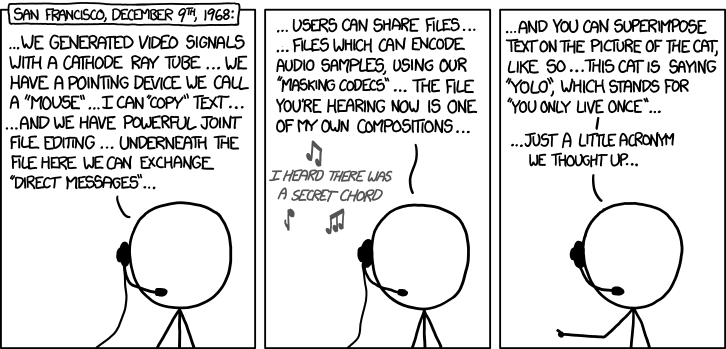Douglas Engelbart (1925-2013)

Actual quote from The Demo: '... an advantage of being online is that it keeps track of who you are and what you’re doing all the time ...'

Actual quote from The Demo: '... an advantage of being online is that it keeps track of who you are and what you’re doing all the time ...'
The comic describes and references the engineer Douglas Engelbart's computer demonstration The Mother of All Demos in honor of Engelbart, who died on July 2, 2013.
The demo is renowned for the numerous technologies Douglas' team introduced, which the comic references before sliding into apocryphal claims. In the first panel he presents various inventions, including the computer mouse. The second panel contains the opening lyrics of Leonard Cohen's song Hallelujah. The "Secret Chord" is a reference to the "Chord Key Set" that he presented at this demo. This relatively obscure device, essentially a piano with five keys, was meant as an alternative to the well-known keyboard. The way he introduces the song is also a reference to musical demo tapes, in which an artist presents a new piece of original music, tying it back to the Mother of All Demos title. The third is a reference to contemporary internet memes, specifically cat pictures and YOLO.
The title text is a reference to recent revelations about spying by the United States National Security Agency, which was making headlines when this comic was published. While it might have seemed like an advantage at the time, in a modern context this aspect of the internet appears disturbing.
The inventions in detail
Several of the inventions presented by Douglas in 1968 were years ahead of their time, and many would prove to be very influential in the development of personal computing. Some of the technologies demonstrated found success in the following decades, while others did not.
Although the following technologies were shown in the demo, Munroe's text does not follow a transcript.
Cathode ray tube
- The German physicist Ferdinand Braun invented the Cathode ray tube, or CRT, in 1897. The Russian scientist Boris Rosing was the first to use the CRT to receive a video signal. CRT was the most common technology used for television screens and computer monitors in the last century, but has since been succeeded by modern devices such as OLED, plasma display, or the ubiquitous LCD. In the demo, Douglas used CRT monitors to demonstrate video conferencing, as well as collaborative real-time editing.
Computer mouse
- Douglas did refer to this device as a "mouse", but officially it was named the "X-Y Position Indicator for a Display System". He filed a patent for this device on June 21, 1967 and received the patent on November 17, 1970. The demo transcript records that Douglas stated: "I don’t know why we call it a mouse...it started that way and we never did change it."
Text movement/cloning
- This is well known today as "cut, copy and paste". On some early text-based systems, the user moved the cursor to the beginning of the text to be copied, typed <CTRL>+K+B , and then moved the cursor to the end of the copied text and typed <CTRL>+K+E. At the demo, Douglas demonstrated that the same task could be accomplished with the mouse.
- Today, people do not have to use keyboard commands for cut, copy and paste, and instead use the mouse or touchscreen gestures, which may be even more convenient for image cutting, copying and/or pasting). But the modern versions of these keystrokes (e.g. shift-cursor highlighting/positioning and then using the Ctrl key, or commonly the ⌘ 'command' key on Apple systems, together with X/C/V for cut/copy/paste) are still considered a useful baseline method, or notable by their absence.
Joint file editing
- Text editors were in the nascent stage of their development in 1968. Douglas demonstrated the first text editor capable of "joint file editing". The first successful system to implement joint file editing came 15 years later, when CVS was made available in the middle of the 1980's.
- Although not referred to as e-mail, Douglas demonstrated the exchange of "direct messages", which fulfills a similar role to modern e-mail. Nowadays, though, the name will be more familiar as the term for private messaging functions on social media.
File sharing
- The demo also demonstrated the exchange of files between users, paving the way for modern file sharing, and the associated legal and ethical debate.
Audio codec
- Douglas demonstrated a "masking codec" capable of coding and decoding an audio stream. This would eventually lead to the development of the wide variety of modern audio codecs, including the MP3 codec, which was produced by the Fraunhofer Society.
Concepts that Douglas did not invent
From the bottom of the second panel the comic exaggerates the idea that Douglas introduced the future to a hilarious and ridiculous level.
"Hallelujah"
- This song was first released by Leonard Cohen in 1984, sixteen years after Douglas's demo.
- A form of image with large text, typically block capitals in the font "Impact", superimposed over a photograph, typically for humorous effect.
- The most famous of the image macros, featuring cats.
YOLO
- As the fictional Douglas states, this is an acronym for "you only live once". The phrase has been around for at least a century, but was coined as an acronym around 2011, and became a popular catchphrase following its use in the rap song "The Motto" by rapper Drake.